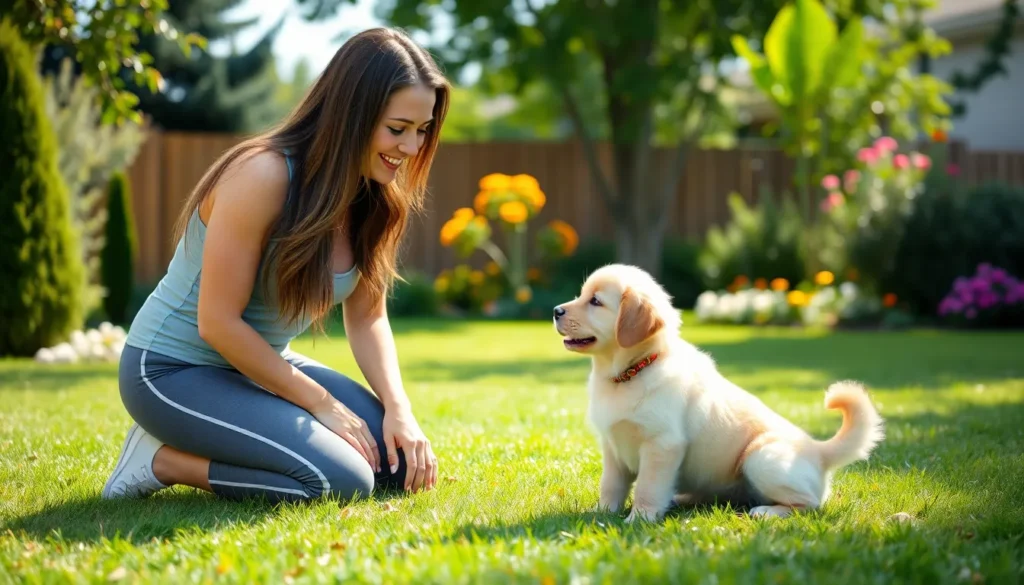Table of Contents
ToggleTraining a dog might seem like a Herculean task, but it’s more like teaching your furry friend to master the art of “sit” and “stay” without turning your living room into a circus. With a little patience and the right techniques, anyone can transform their pup from a wild whirlwind into a well-mannered companion.
Understanding Dog Training
Training a dog plays a vital role in ensuring a harmonious relationship between pet and owner. It fosters communication and sets clear expectations.
Importance of Training
Training a dog establishes boundaries and encourages good behavior. Effective training reduces behavioral issues that can lead to frustration. A well-trained dog faces fewer problems with obedience and adapts better to various environments. Proper training builds a foundation for safety, ensuring that the dog responds reliably to commands. Consistency during training helps reinforce learned behaviors, making it easier for the dog to understand what is expected.
Benefits of Training Your Dog
Training a dog offers numerous advantages. Improved socialization occurs when dogs learn to interact with people and other animals positively. Enhanced mental stimulation results from engaging the dog during training sessions, keeping their mind active. Stronger bonds form between the owner and the dog through shared experiences in training. Training promotes physical exercise, benefiting the dog’s health. Lastly, trained dogs often enjoy increased freedom, as their owners trust them to behave in various situations.
Training Methods

Training methods play a crucial role in developing a well-behaved dog. Understanding the various approaches ensures effective learning.
Positive Reinforcement
Positive reinforcement encourages desired behaviors through rewards. Treats, praise, and toys act as motivators, making training enjoyable. This method builds trust between the owner and dog, strengthening their bond. By consistently rewarding good behavior, dogs learn to repeat these actions. For example, giving a treat when a dog sits or fetches reinforces these tasks. Furthermore, positive reinforcement can reduce anxiety and fear during training sessions. The association of training with positive experiences results in a more willing learner.
Clicker Training
Clicker training utilizes a small device that makes a distinct sound to mark desired behaviors. Timing is essential, as the click reinforces an action immediately. Owners can pair the click with a reward, establishing a clear communication method. Use this method for commands such as “sit,” “down,” and “stay.” Practicing regularly helps dogs understand expectations better. Consistency with the clicker and rewards leads to faster learning and improved responsiveness. Many trainers adopt this method for its effectiveness and simplicity, making it suitable for various dog breeds.
Obedience Training
Obedience training focuses on teaching commands that enhance a dog’s behavior. Basic commands like “sit,” “stay,” and “come” lay a foundation for effective communication. Owners should engage in regular practice sessions to reinforce these commands. Using structured classes or sessions provides guidance for both the dog and the owner. As dogs master commands, they gain confidence and develop better self-control. Obedience training significantly improves the relationship between pets and their owners, ensuring safety and control in various situations. Consistent training sessions lead to improved behavior and a well-adjusted pet.
Basic Commands
Basic commands lay the essential foundation for dog training. These simple phrases help create a clear communication channel between the pet and owner.
Sit
To teach “sit,” begin with a treat as motivation. Hold the treat above the dog’s head and move it back toward the tail. As the dog looks up, its bottom will likely touch the ground. The moment this happens, reward the dog with the treat and praise. Consistent repetition leads to a faster understanding of the command. Ensure practice occurs in various environments to help the dog generalize the command. Dogs grasp “sit” quickly; hence, this command serves as a starting point for further training.
Stay
“Stay” requires patience and consistency. Start with the dog in a sitting position. Use a firm yet gentle voice to say “stay.” Take a step back; if the dog remains in position, reward it promptly. Gradually increase the distance and duration as the dog becomes more comfortable with the command. Practicing “stay” in different settings enhances reliability. Be patient, as some dogs need more time to master this command than others. Ultimately, successful execution promotes discipline and reinforces trust between owner and dog.
Come
To train “come,” begin in a controlled environment with minimal distractions. Use a cheerful tone to call the dog by name followed by the command “come.” When the dog approaches, immediately reward it with treats and praise. Building positive associations strengthens the response. Practice this command regularly in various locations, gradually introducing distractions. Successful completion ensures safety, as a dog that reliably comes when called can avoid dangerous situations. Reinforcing this command is crucial for effectively managing the dog’s behavior outdoors.
Advanced Training Techniques
Advanced training techniques enhance a dog’s learning experience. Trainers can utilize methods like leash training and house training to achieve significant progress.
Leash Training
Leash training establishes proper walking behavior. Start with introducing a collar and leash, allowing the dog to adjust. Gradually increase the walk distance while rewarding relaxed behavior. Using treats reinforces positive actions, encouraging the dog to stay close. Redirecting when the dog pulls prevents bad habits from forming. Regular practice ensures a calm and enjoyable walking experience.
House Training
House training focuses on teaching the dog where to eliminate. Establishing a routine is crucial for success. Taking the dog outside after meals and during regular intervals helps create consistency. Monitoring for signs of needing to go outside aids in preventing accidents. Rewarding the dog for eliminating outside reinforces desired behavior. Patience and consistent scheduling lead to a well-trained dog in the house.
Common Challenges
Dog training poses various challenges that owners may encounter. Addressing these difficulties enhances the training experience and fosters a stronger bond between pet and owner.
Behavioral Issues
Behavioral issues can arise during training, making it essential to recognize and address them promptly. Common challenges include excessive barking, jumping, and chewing. Identifying the triggers behind these behaviors helps in developing effective strategies. Consistency in reinforcement plays a crucial role in managing unwanted actions. For example, redirecting jumping to a sit command teaches the dog an acceptable alternative. Additionally, socialization with other dogs and people helps to mitigate anxiety-driven behaviors. Owners might consider consulting a professional if issues persist, ensuring a well-adjusted pet.
Addressing Fear and Anxiety
Fear and anxiety often complicate the training process. Dogs may exhibit signs of distress in new environments, around unfamiliar people, or during loud noises. Understanding these triggers aids in crafting a tailored training plan. Gradual exposure to anxiety-inducing situations can help alleviate fear. Using positive reinforcement reinforces calm behavior, building confidence over time. For instance, rewarding a dog for remaining calm during a thunderstorm fosters resilience. Creating a safe space at home provides comfort during stressful moments. Implementing these strategies contributes to a well-rounded, confident pet.
Training a dog is a rewarding journey that strengthens the bond between pet and owner. With the right techniques and a commitment to consistency patience can lead to a well-behaved companion. Embracing positive reinforcement and structured sessions not only enhances obedience but also fosters trust and confidence in the dog.
Addressing behavioral challenges promptly and creating a supportive environment contributes to a happier and healthier pet. By investing time and effort into training every owner can enjoy the benefits of a well-trained dog. This not only improves the quality of life at home but also ensures safety and harmony in daily interactions.




